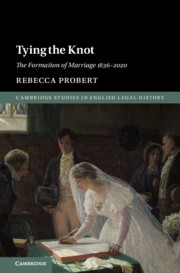Book contents
- Tying the Knot
- Cambridge Studies in English Legal History
- Tying the Knot
- Copyright page
- Dedication
- Contents
- Preface and Acknowledgements
- Abbreviations
- 1 Introduction
- 2 Conception, Design, and Implementation, 1819–1837
- 3 Reactions to the Act, 1837–1854
- 4 Amendments Enacted and Reform Deferred, 1855–1872
- 5 Differences, Divisions, and Dispensing with the Registrar, 1873–1899
- 6 Competing Conceptions of Marriage, 1900–1919
- 7 Consolidating Complexity, 1920–1949
- 8 Convergence? 1950–1993
- 9 The Rise of the Wedding, 1994–2020
- 10 The Legacy of the Past and Lessons for the Future
- Index
3 - Reactions to the Act, 1837–1854
Published online by Cambridge University Press: 10 September 2021
- Tying the Knot
- Cambridge Studies in English Legal History
- Tying the Knot
- Copyright page
- Dedication
- Contents
- Preface and Acknowledgements
- Abbreviations
- 1 Introduction
- 2 Conception, Design, and Implementation, 1819–1837
- 3 Reactions to the Act, 1837–1854
- 4 Amendments Enacted and Reform Deferred, 1855–1872
- 5 Differences, Divisions, and Dispensing with the Registrar, 1873–1899
- 6 Competing Conceptions of Marriage, 1900–1919
- 7 Consolidating Complexity, 1920–1949
- 8 Convergence? 1950–1993
- 9 The Rise of the Wedding, 1994–2020
- 10 The Legacy of the Past and Lessons for the Future
- Index
Summary
The reactions to the 1836 Act were just as diverse and complicated as the campaign for reform had been. The new civil preliminaries – required unless a couple were marrying in the Anglican church – were not calculated to encourage take-up. Nonetheless, some couples actually chose civil preliminaries over Anglican ones, leading to conflict between clergy and registration officials. Catholics were more likely to register their places of worship for marriage and to get married there, although some priests got into trouble when they conducted ceremonies in such registered chapels otherwise than in accordance with the law. Protestant Dissenters were proportionately far less likely to register their places of worship for marriage, or to marry there. Few married in a register office, although those who did were able to include prayers and Bible readings, underlining how this particular option was intended to complement that of marrying in a registered place of worship. Quaker weddings continued much as before, although falling numbers meant that individual Quakers were limited in their choice of spouses. Jewish weddings similarly continued as before, but the breakaway Reform synagogue found itself refused recognition by the Board of Deputies and its members had to resort to the register office.
Keywords
- Type
- Chapter
- Information
- Tying the KnotThe Formation of Marriage 1836–2020, pp. 54 - 84Publisher: Cambridge University PressPrint publication year: 2021



